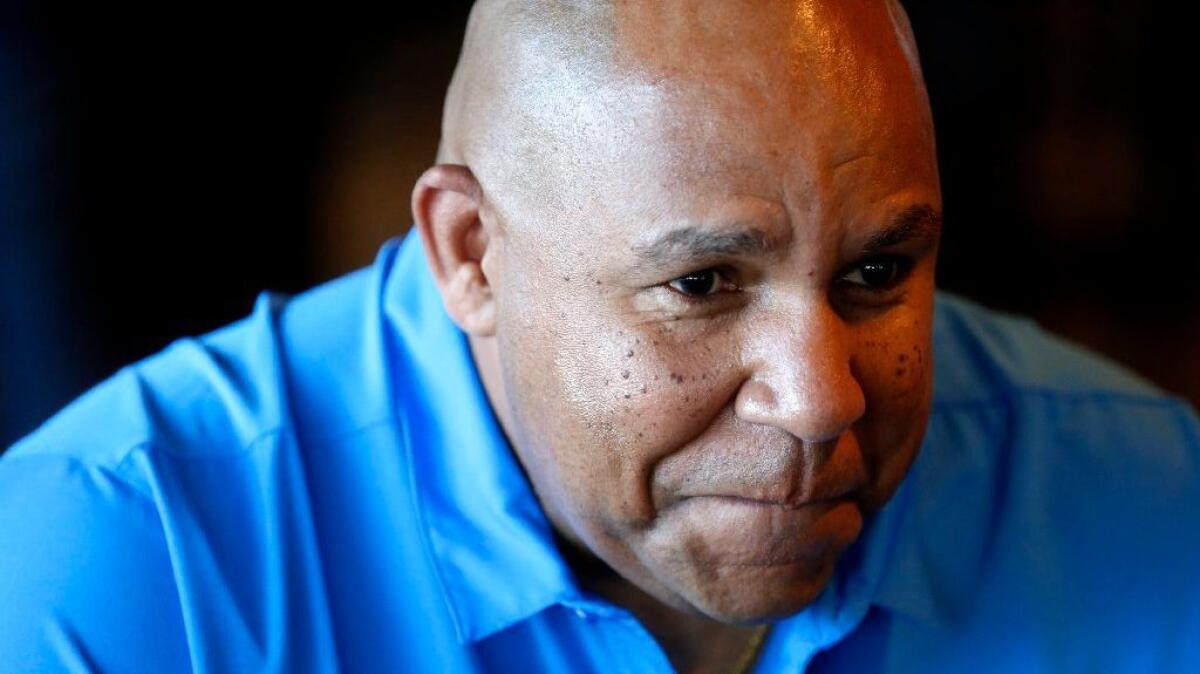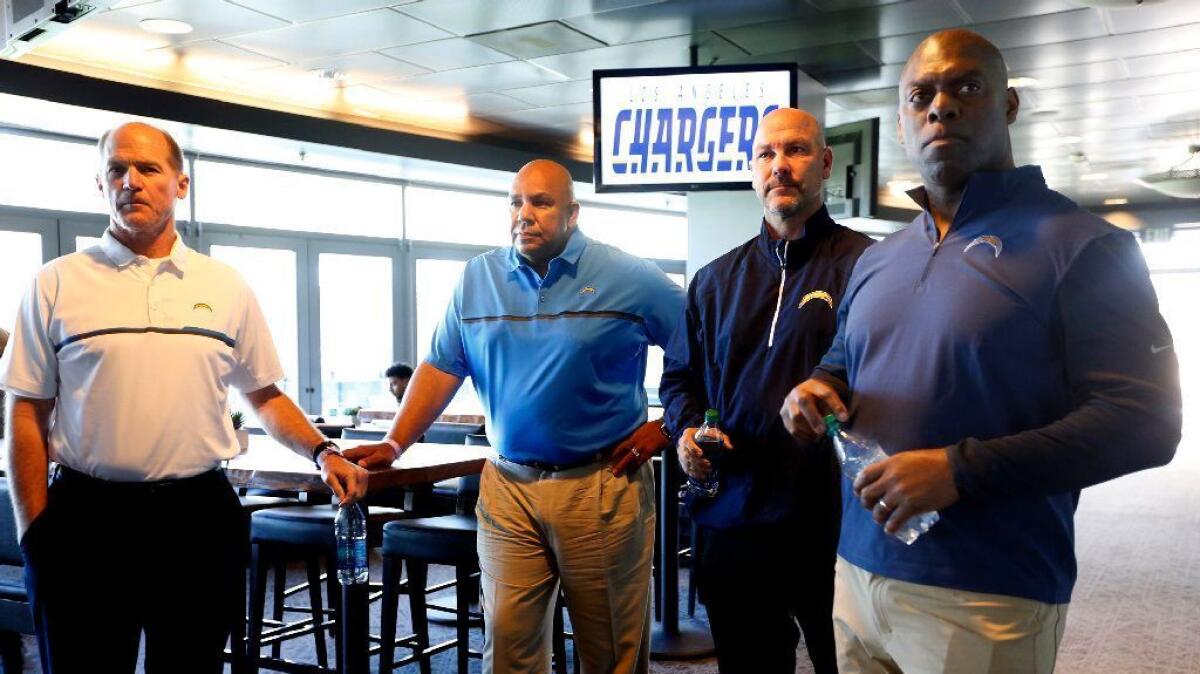Chargers special teams guru George Stewart made Anthony Lynn better as a player, so Lynn hired him as a coach

- Share via
George Stewart walked through the terminal at Dallas/Fort Worth International Airport and saw a stranger with a familiar frame.
The broad shoulders, the defined arms, the powerful legs, the tree-trunk neck. Stewart knew this man wasn’t an accountant, wasn’t a chef, wasn’t a salesman. This stranger, he was a football player.
It was 1996 and Stewart was traveling to San Francisco to run George Seifert’s special teams units. He was right about that stranger — the man was a football player also headed to the 49ers. He was a backup running back about to enter his third season.
His name was Anthony Lynn.
Twenty-one years later, the two men have reunited. Lynn tabbed Stewart to fix the Chargers’ special teams, which have been a mess the last two seasons. Using the Dallas Morning News’ formula for evaluating all phases of special teams, the Chargers had the worst unit in the NFL in those seasons.
Lynn also named Stewart the team’s assistant head coach.
“When a coach makes you better, that’s what gets an NFL player’s attention,” Lynn said. “And he made a lot of us better.”
Stewart didn’t speak to Lynn at the airport that day, but recognized the face and build in a meeting room at the 49ers complex. In their one year together, Stewart formed a bond with Lynn, one built on immense trust.
He knew it in the meeting room when he saw Lynn scribbling ideas and reminders into a loose-leaf notebook. And he knew it on the football field. “This guy was making tackle after tackle. Kickoff return, he’s blocking people. ‘This guy could be captain,’” Stewart thought.
Stewart played for Lou Holtz at Arkansas and then coached for him, and later worked in the NFL for Chuck Noll in Pittsburgh, Seifert and Bill Walsh in San Francisco and Dan Reeves in Atlanta. He tutored players like Tim Brown, Rod Woodson and Terrell Owens. He won a national title with Holtz’s 1988 Notre Dame team.

“A legends tour,” he said with a chuckle.
Stewart grew up as a part of an average Arkansas family — or so he thought.
“I had a normal childhood because I didn’t know what I didn’t know,” he said. “I always thought we were middle class. I didn’t know I was poor. … I didn’t get a chance to see the other side of my community. … The thing that changed me and my perspective was the integration of schools.”
The 30-minute bus ride from his family’s home to Parkview Arts and Science Magnet High opened Stewart’s eyes to a new world, one with nicer houses and manicured front lawns. He knew he wanted it, driving those streets on Sunday afternoon with his girlfriend at the time, window shopping for his future.
Football, it seemed, would be the vehicle to get it.
A dominant offensive lineman, Stewart helped Parkview win its first state title. From there, he joined Holtz’s team at Arkansas, where he became a top pro prospect.
But a devastating knee injury, a torn patellar tendon, ended his senior year early, and Stewart fell from a potential top-10 pick off of everyone’s draft board. He eventually signed with the Kansas City Chiefs, but another knee injury forced him into retirement.
Stewart considered a job in education — it was his major at Arkansas — but decided that he wanted to run his own car dealership. He worked summers at Rick Moore Ford in Little Rock. He spent time in the shop, on the floor and in the back, learning all aspects of the business.
He even got hooked up with a minority ownership program, allowing him to put up 10% in a new dealership while Ford would put up the other 90%. This, Stewart figured, would get him that nice front lawn.
“I wanted a dealership. And I was working toward that when I got a phone call. And it was Coach Holtz,” Stewart said.
Holtz wanted him to come be a graduate assistant coach at Arkansas.
“He told me, ‘For three months, just try it. You can always go back and have your dealership and sell your cars,’” Stewart said.
Those three months turned into 30-plus years of coaching.
“My life should be a book,” Stewart said.
Stewart followed Holtz to Minnesota and then to Notre Dame, where he ran the Fighting Irish’s special teams. A seemingly innocuous trip to the NFL combine in 1989 led to a job with Noll and the Steelers.
The opportunity, which Stewart had no knowledge of before the trip, came because there were doughnuts next to the free coffee.
Visiting with a former co-worker, longtime coach Foge Fazio, the men spotted Noll near the coffee machine. Stewart, who doesn’t drink the beverage, saw the free doughnuts and went with Fazio to say hello.
“Foge is like, ‘Hey Chuck, this is George Stewart. He’s interested in that special teams job you’ve got in Pittsburgh,’” Stewart recalled. “I’m like, ‘What?’ Chuck looked at me, shook my hand and said, ‘George, I appreciate it but I have someone in mind.’ I’m thinking, ‘Great. I wasn’t really interested anyway.’”
Just as that conversation ended, Raiders owner Al Davis walked by and spotted Stewart, who helped Brown win the Heisman Trophy at Notre Dame. The Raiders had picked Brown sixth overall in the previous year’s draft.
Davis wanted to know why Stewart wasn’t out recruiting. Stewart, startled that Davis was speaking to him, said something about already having enough players.
“Thank you so much for Tim Brown,” Davis told Stewart.
And with that, Pittsburgh’s special teams job came back on the market.
“Chuck looks at me and says, ‘Well, what are you doing next Thursday?’” Stewart recalled.
The interview led to a job, where Stewart resuscitated the Steelers’ special teams. From there, he went to Tampa Bay before landing in San Francisco, a job that took him through the Dallas airport into a meeting room with his future boss.
In Week 12 of his first year in San Francisco, the 49ers hosted Baltimore and rookie returner Jermaine Lewis, a player Stewart identified in his scouting.
“We were watching tape as a group, and I said, ‘This guy, 84, Jermaine Lewis, no one knows who he is because he’s a rookie, but this guy is going to be a great player before it’s all said and done. Let’s make sure that through this week, nobody still knows his ass,’” Stewart said. “… We had a special coverage designed for what they were doing. But I had to have a guy I could trust.
“And that guy was Anthony Lynn.”
The play called for Lynn to kind of blindside Lewis. Hit him and make a big play or miss him and probably give up a touchdown.
Lynn didn’t miss.
“If I am one-on-one, I thought it’s going to be hard as hell to tackle him in space,” Lynn said. “But that play, it was designed to perfection. He knew exactly what was going to happen, and I took the young man out.”
Lewis fumbled and didn’t play the rest of the afternoon. Lynn had earned Stewart’s trust for life.
“I had a lot of hits, but that’s one I remember,” Lynn said. “Because when Stew got there — I had learned special teams techniques, fundamentals, beat the man in front of you — Stew, to me, brought scheme to special teams. We had actual plays.”
And now the Chargers need actual results.
With the team moving to Los Angeles, searching for answers as to why it lost so many close games last season, the yards lost in coverage, the kicks missed, the shanks and the botched snaps all need to be corrected.
Stewart hasn’t coached that unit in almost two decades, leaving special teams behind to try to build his resume by coaching wide receivers in San Francisco, Atlanta and Minnesota.
But Lynn knew if he ever needed a special teams guru, Stewart would be at the top of his list.
“When I got this job, I didn’t think there was any way in hell I could get him,” Lynn said. “But I knew I had to try. And I just caught him at a point in his life where he wanted to go back to doing what he loved.”
The trust Stewart eventually placed in that stranger at the airport, it’s now been returned 17 years later.
“It means a lot,” Stewart said.
Follow Dan Woike on Twitter @DanWoikeSports
More to Read
Go beyond the scoreboard
Get the latest on L.A.'s teams in the daily Sports Report newsletter.
You may occasionally receive promotional content from the Los Angeles Times.







